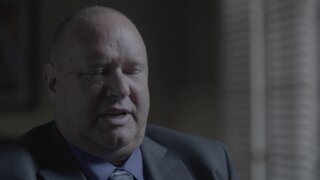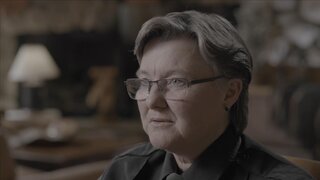Create a free profile to get unlimited access to exclusive videos, breaking news, sweepstakes, and more!
A Young Father Disappears For A Second Time From A Copper Mining Site — What Happened?
Was Bryan Ruff an overwhelmed father who walked away from his life? Or did something more sinister happen? The theories ran wild around the 1991 disappearance of a man who simply vanished from his graveyard shift.
Authorities wondered if a man voluntarily disappeared for a second time when he was reported missing from a copper mining site in 1991.
South Carolina-born Bryan Ruff began dating a woman named Jennifer at age 16 before they got married and had a child. The fun-loving and high-spirited couple moved to Utah to rear their child in the Mormon faith and be nearer to Jennifer’s parents, who could help the young couple transition into parenthood. There, Bryan began pursuing his nurse’s degree and took up the graveyard shift as a security guard at the Kennecott copper mine on Utah’s gold belt.
“It was a lot of pressure on him to do everything,” his wife, Jennifer Campbell, admitted to "Buried in the Backyard," airing Thursdays at 8/7c on Oxygen. “To be there for me and the baby, and to also be a provider, and also going to school to get a better education.”
Soon, Jennifer and Bryan learned they were expecting baby number two. As much as they loved each other, they had to work hard at their jobs to financially support their growing family, which added strain to the relationship. Then, on one chilly November morning in 1991, Bryan didn’t return home from his night shift. Jennifer found a hand-written letter where Bryan claimed he was stressed and needed time to think.
“I was four months pregnant at the time and had a 13-month-old baby,” said Jennifer. “So it was scary, and I didn’t know what exactly was going on.”
Jennifer called Bryan’s boss at the copper mine, who relayed that Bryan turned in his security badge and quit his job on the spot. Bryan left the job site with his final paycheck and drove off in his and Jennifer’s vehicle.
Several weeks later, Jennifer had to take their daughter to the emergency room after she contracted viral pneumonia. When word of their daughter’s health reached Bryan, he returned to his family.
Bryan profusely apologized, and Jennifer took him back. Things seemed to be getting back on track. Bryan regained employment at the copper mine, and the future looked bright for the young couple. But on Dec. 10, 1991, just weeks after Bryan fell off the radar to clear his head, Jennifer received a call from the Salt Lake County Sheriff’s Office to say Bryan was missing from his security post. He left behind his car and his half-eaten lunch.
Local law enforcement agencies were alerted when the sheriff’s office received a phone call that rang peculiar.
“We had somebody call in saying that they were Bryan’s wife, Jennifer,” said Ret. Det. Manny Lassig of the sheriff’s office. “But we had Jennifer’s information, and the phone number wasn’t right.”
Authorities traced the phone call back to Bryan’s friends, married couple Dale and Christy Bradley. Christy told deputies she made the call because she wanted to know more about Bryan’s disappearance but knew she wouldn’t be privy to some of the inside information, seeing as she was just a friend. As authorities interviewed Christy at her home, Dale returned from his job, where he worked alongside Bryan at the copper mine. He explained it wasn’t the first time Bryan had up and left.
Bryan’s parents, Franklin and Patricia Ruff, hoped their son would show up at their South Carolina home. Patrica told Oxygen her son had wanted to return for Christmas but couldn’t afford the airfare.
“Every day, we were wondering and hoping that he did just take off, and maybe he was on his way out here,” said Franklin.
Next, detectives interviewed Bryan’s manager, Todd Fallows, the first to notice Bryan’s absence from his security post. The investigation shifted when authorities found strong indications of shady activity at the copper mines that could account for Bryan’s disappearance. In recent months, thieves stole more than $150,000 worth of material from the site.
“If somebody from Kennecott abducted Bryan and killed him, there were places they could put him on the Kennecott property where he would never be found,” said Fallows, as per recordings that exist today. “There were two different ideas. One of them was in the gravel pile at the concentrator, where he would have been sucked down into the grinders themselves and ground up with all of the rocks. The other one was underneath the big tailings piles. The big boulders would cover him up, and they would never find him. Ever.”
Fallows fell under suspicion when a separate investigation revealed Fallows’ alleged involvement with the theft ring. Could it have been that Bryan found out about his boss’s criminal involvement? Fallows — the last known person to see Bryan — was ultimately terminated from his job and named a person of interest in the case.
But nothing ever firmly connected him to Bryan’s disappearance.
For Jennifer, the bills began piling up. But one caught her eye: it was a credit card bill that showed Bryan’s movements when he disappeared for the first time, making stops at a local hotel and then in Reno, finally stopping in San Francisco. That’s where Bryan was when he learned his daughter was sick in the hospital back in Utah. Jennifer took on the role of sleuth and called a San Francisco phone number listed on the bill.
“The gentleman answered the phone and told me he was Christy Bradley’s uncle and that Christy had come for a visit a few weeks prior,” said Jennifer. “And I asked Christy’s uncle if he knew Bryan, and he said that they had introduced Bryan as Christy’s new husband.”
Could the affair explain Bryan’s disappearance?
Detectives looked into Jennifer and Christy, who had strong alibis to keep them above suspicion. They also probed Christy’s husband and Bryan’s coworker, Dale Bradley, who said he was at the library when Bryan disappeared. That evening, Dale’s car got stuck on the ice, but he called a friend for help. It was when Dale came home that he found investigators speaking to Christy for the first time shortly after Bryan’s disappearance.
But Dale later claimed his car was in fine working order before calling the friend. He couldn’t seem to keep his story straight.
“There were just a bunch of different stories,” said Deputy District Attorney Vincent Meister. “And each time he told it, there’s a little bit [of] a different angle.”
Dale permitted investigators to search his car. Nothing seemed amiss, but detectives collected samples of paint and mud from the vehicle. They noted a larger dent on the exterior, which Dale passed off as his doing when he slipped on the ice.
Months went by, and the leads dried up. Jennifer believed if the birth of their second child wasn’t enough to bring Bryan back, then the hope of finding him alive was dim. She would be proven right on July 10, 1993, when four young campers wandered around the Five Mile Pass in the desolate high desert of Utah. The group found what appeared to be fabric sticking out from some sheet metal lying on the ground. Soon, they discovered skeletal remains. On the body were Bryan Ruff’s identification cards and other personal items. A boot with a bullet hole was found nearby.
A medical examiner determined Bryan was shot five times in the back.
“The frustration of it is, yeah, we recovered Bryan Ruff’s remains, but we weren’t any closer to finding the person who was responsible for what happened to Bryan Ruff,” said Det. Lassig.
It would take an entire decade for loved ones to get answers when a second murder occurred about 100 miles away in Wellington, Utah. On April 5, 2005, Carbon County authorities received reports of a body found in a residential front yard. The woman was Crystal Bradley, the second wife of Dale Bradley. Her death was ruled a homicide.
Authorities found similarities in the cases, believing Dale could have killed his new wife after she confessed to having an extramarital affair and expressed her desire to leave her husband for the new man.
Carbon County investigators looked back at Bryan Ruff’s case and quickly found holes in Dale Bradley’s initial story of being at the library when Bryan vanished. Payphone records placed Dale closer to the crime scene when he called his friend for help.
Authorities reached out to Utah County authorities, who kept the evidence found at Bryan’s burial site.
“When I looked at the boot for the first time, I saw a paint scuff on the bottom of the boot,” said Ret. Det. Scott Park of the Unified Police Department. “I was surprised to find out that the paint wasn’t talked about in any of the last police reports. To me, it looked like that boot had kicked at something which created the scuff.”
The reddish-orange paint matched the paint chips collected from Dale Bradley’s car by Salt Lake County investigators in their initial 1991 investigation.
In September 2005, Dale Bradley was formally charged with the murder of Bryan Ruff. Investigators believed Dale forced Bryan into the trunk of his car before driving up to Five Mile Pass, where he made Bryan dig his own grave. Bryan was shot while in or near the hole he’d just dug.
In January 2007, Dale Bradley pleaded guilty to second-degree felony manslaughter and kidnapping charges.
“There was more to Bryan than those last few weeks of his life,” Jennifer told "Buried in the Backyard." “He made some bad decisions, but he was a good person. He had a kind heart. And I’ve always made sure that my girls know that they were born to parents that love them and wanted them.”
Bryan and Jennifer’s children have grown to get married and have children of their own.
Dale Bradley is serving his 40-year sentence at the Central Utah Correctional Facility in Gunnison, Utah. No one has ever been charged in connection with the death of his second wife, Crystal Bradley.
For more on this case and others like it, watch "Buried in the Backyard," airing Thursdays at 8/7c on Oxygen or stream episodes here.






















